The Night Sky May 2015
Compiled by Ian Morison
This page, updated monthly, will let you know some of the things that you can look out for in the night sky. It lists the phases of the Moon, where you will see the naked-eye planets and describes some of the prominent constellations in the night sky during the month.
Cambridge University Press has recently published two books by the author.
An Amateurs Guide to Observing and Imaging the Heavens is a handbook aimed to bridge the gap between the beginner's books on amateur astronomy and the books which cover a single topic in great detail. Stephen James O'Meara and Damian Peach have both given it excellent reviews.
'A Journey through the Universe' covering our current understanding of the Universe (up to June last year) was published on the 25th of September. Martin Rees has written a very nice review of it.
Image of the Month
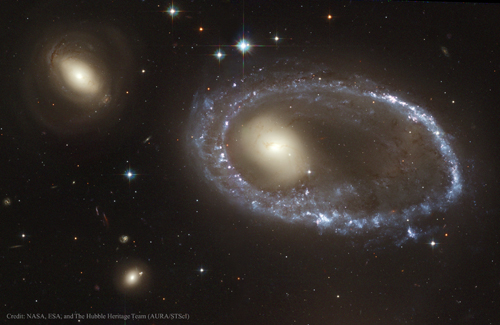
Hubble Image of the Ring Galaxy AM 0644-741
Image:AURA/STScI,J.Higdon (Cornell) ESA, NASA
The Galaxy AM 0644-741 is a ring galaxy lying at a distance of ~300 million light years whose shape was caused by an immense galaxy collision. Though the two galaxies will have passed through each other, their stars would rarely have collided. The ring-like shape is caused by the gravitational disruption as the small intruder galaxy passed through the large one. This caused a wave of star formation to move out from the impact point like a ripple on the surface of a pond. This image was taken to commemorate the anniversary of Hubble's launch in 1990.
Highlights of the Month
May - our best month to view Saturn.
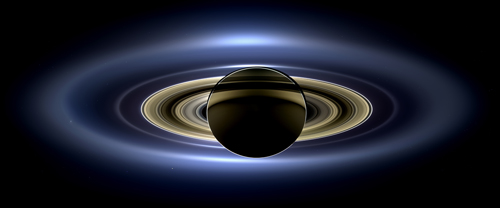
Cassini image of Saturn
Saturn reaches opposition - that is when it be approximatly due south at midnight (UT) or 1 am (BST) - on the 23rd of May, so it will be visible for most of the hours of darkness. The beautiful ring system has now opened out to ~24 degrees - virtually as open as they ever become. Saturn brightens to magnitude 0.0 during the month - the brightest it has been for eight years - largely due to the fact that the ring system is now quite open. Its globe spans 18.5 arc seconds across and the ring system 42 arc seconds.
Around opposition we see an interesting phenomenon known as the Seeliger effect. When we are looking directly away from the Sun, the shadows projected by each particle of ice in the ring system fall directly behind them and so do not fall on other particles so reducing their apparent brightness. Thus, for a few days around opposition, the ring system appears somewhat brighter than normal. Saturn is moving in retrogade motion, that is westwards, away from the double star Beta Scorpii back towards Libra which it reaches on the 12th. If only Saturn were higher in the ecliptic; its elevation never gets above ~18 degrees and so the atmosphere will hinder our view of this most beautiful planet. In late April I was in the Sahara Desert at a latitude of +29, so Saturn was around 23 degrees higher in the sky and, on a night of superb seeing, looked wonderful.
May: Look for the Great Red Spot on Jupiter
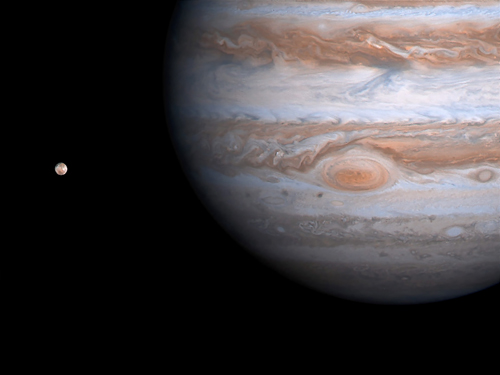
Observe the Great Red Spot
Image: NASA
This list gives some of the best evening times during May to observe the Great Red Spot which should then lie on the central meridian of the planet.
2nd 21:02 26th 20:58
4th 22:41 28th 22:37
9th 21:50
14th 21:00
16th 22:39
21st 21:48
23rd 23:28
May 2nd after sunset: Mercury and the Pleiades Cluster
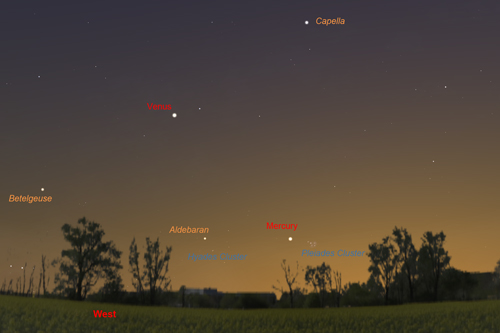
Mercury and the Pleiades Cluster
Image: Stellarium/IM
Given a low horizon in the West-Northwest and clear skies you should be able to spot Mercury halfway between the Pleaides Cluster (right) the Hyades Cluster (left) with Aldabaran lying between the cluster and us. Orion will be setting to the left of the Hyades cluster.
May 6th before dawn: The Eta Aquarid Meteor Shower
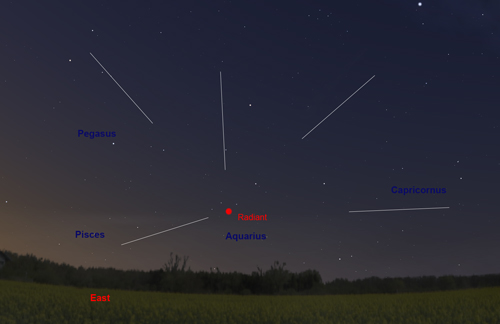
The Eta Aquarid Meteor Shower
Image: Stellarium/IM
The Eta Aquarids are one of the finest meteor showers that can be seen from the southern hemisphere, but may be glimpsed in the pre-dawn sky in the south-east around 90 minutes before dawn. A waning gibbous Moon will hinder our view somewhat so only the brighter meteors will be seen.
May 20th, 10pm onwards: Transits of Io and Callisto across the face of Jupiter
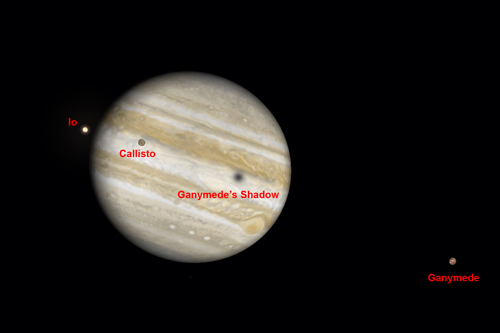
Io and Callisto transit Jupiter
Image: Stellarium/IM
Jupiter is coming towards the end of its apparition but this evening, given clear skies and a moderate aperture telescope, you should be able to see Io and Callisto transit across the face of the planet with Ganymede's shadow preceeding them as shown on the diagram.
May 21st and 22nd: 1 hour after sunset - Venus and a crescent Moon.
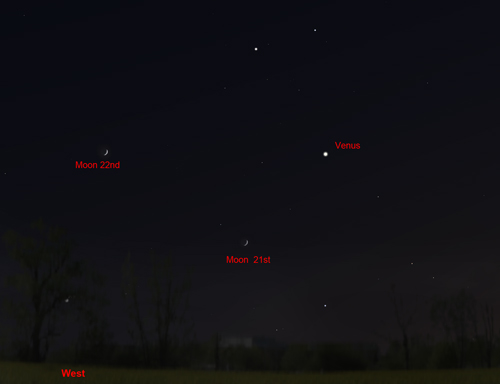
Venus and a crescent Moon
Image: Stellarium/IM
After sunset and as darkness falls, Venus will be seen lying below the stars Pollux (left) and Castor (right) in Gemini. On the 21st, the crescent Moon will lie to lower left of Venus whilst on the 22nd it will lie over to its left.
May 23rd/24th: Jupiter and a crescent Moon
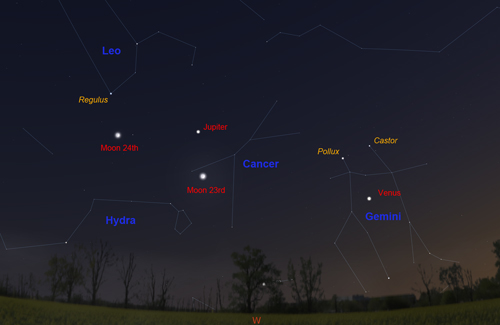
Jupiter and a waxing crescent Moon.
Image: Stellarium/IM
On the 23rd May, after sunset at around 10 pm, given a clear sky and low western horizon, you may be able to see crescent Moon below Jupiter. Both will lie below the mane of Leo, the Lion. On the 24th, the Moon will lie over to Jupiter's left.
May 18-26th around 11 pm: Saturn and Scorpius
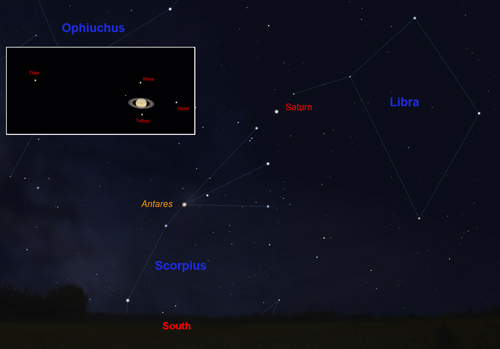
Saturn above the head of Scorpius
Image: Stellarium/IM
Looking Southeast around 11pm, you will see Saturn at magnitude 0.0 above the fan of three stars that form the head of the scorpion. As the night progresses it will move higher in the sky and be highest around 1 am (BST).
May 28th: Comet Lovejoy close to the Pole star
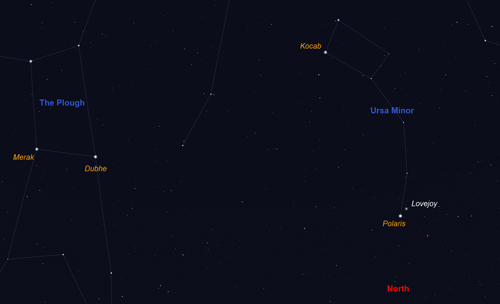
Comet Lovejoy close to Polaris
Image: Stellarium/IM
Comet 2014Q2 (Lovejoy) has been in our skies for some months now. Still visible as a faint 'fuzzy' ball, it passes within a degree of Polaris on the 28th so will be easy to find with powerful binoculars or a small telescope. It will lie above and a little to the right of Polaris.
May 6th and 7th, evening: The Hyginus Rille
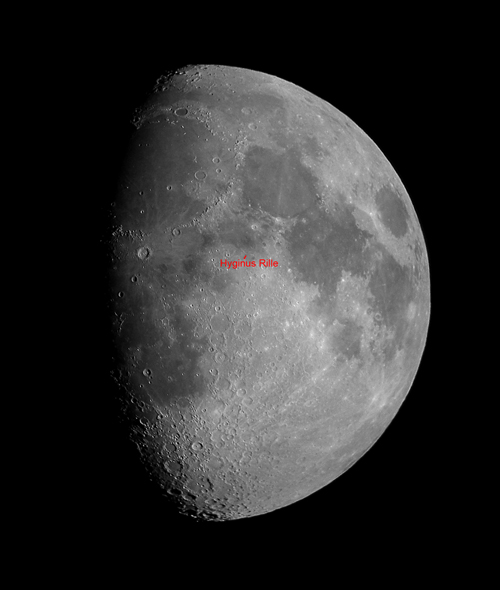
Hyginus Rille location: IM.
These evenings, should it be clear, are a superb time to view the Hyginus Rill as it will lie close to the terminator. For some time a debate raged as to whether the craters on the Moon were caused by impacts or volcanic activity. We now know that virtually all were caused by impact, but it is thought that the Hyginus crater that lies at the centre of the Hyginus Rille may well be volcanic in origin. It is an 11 km wide rimless pit - in contast to impact craters which have raised rims - and its close association with the rille of the same name associates it with internal lunar events. It can quite easily be seen to be surrounded by dark material. It is thought that an explosive release of dust and gas created a vacant space below so that the overlying surface collapsed into it so forming the crater.
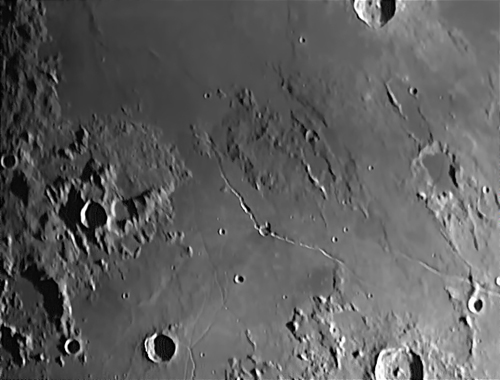
Hyginus Crater and Rille
M109 imaged with the Faulkes Telescope
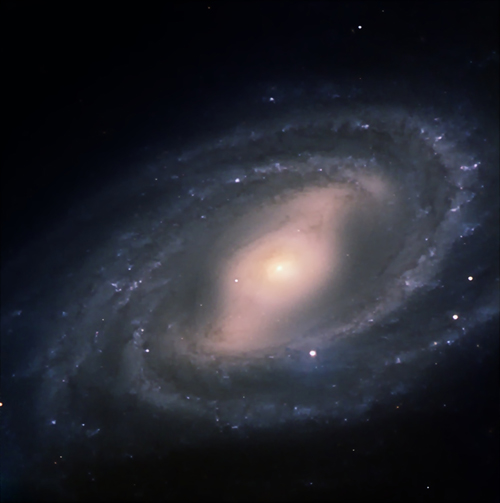
Messier 109
Image: Daniel Duggan
Faulkes Telescope North.
The Barred Spiral galaxy M109, imaged by Daniel Duggan.
This image was taken using the Faulkes Telescope North by Daniel Duggan - for some time a member of the Faulkes telescope team. It shows the barred spiral galaxy M109 that lies at a distance of 83 million light years in the constellation of Ursa Major. It is the brightest galaxy in the Ursa Major group of some 50 galaxies. Our own Milky Way galaxy is now thought to be a barred spiral like M109.
Learn more about the Faulkes Telescopes and how schools can use them: Faulkes Telescope"
Observe the International Space Station

The International Space Station and Jules Verne passing behind the Lovell Telescope on April 1st 2008.
Image by Andrew Greenwood
Use the link below to find when the space station will be visible in the next few days. In general, the space station can be seen either in the hour or so before dawn or the hour or so after sunset - this is because it is dark and yet the Sun is not too far below the horizon so that it can light up the space station. As the orbit only just gets up the the latitude of the UK it will usually be seen to the south, and is only visible for a minute or so at each sighting. Note that as it is in low-earth orbit the sighting details vary quite considerably across the UK. The NASA website linked to below gives details for several cities in the UK. (Across the world too for foreign visitors to this web page.)
Note: I observed the ISS three times recently and was amazed as to how bright it has become.
Find details of sighting possibilities from your location from: Location Index
See where the space station is now: Current Position
The Moon
 The Moon at 3rd Quarter. Image, by Ian Morison, taken with a 150mm Maksutov-Newtonian and Canon G7.
The Moon at 3rd Quarter. Image, by Ian Morison, taken with a 150mm Maksutov-Newtonian and Canon G7.
Just below the crator Plato seen near the top of the image is the mountain "Mons Piton". It casts a long shadow across the maria from which one can calculate its height - about 6800ft or 2250m.
| new moon |
first quarter |
full moon |
last quarter |
`
| May 18th |
May 25th |
May 4th |
May 11th |
Some Lunar Images by Ian Morison, Jodrell Bank Observatory: Lunar Images
A World Record Lunar Image
 The 9 day old Moon.
The 9 day old Moon.
To mark International Year of Astronomy, a team of British astronomers have made the largest lunar image in history and gained a place in the Guinness Book of Records! The whole image comprises 87.4 megapixels with a Moon diameter of 9550 pixels. This allows details as small as 1km across to be discerned! The superb quality of the image is shown by the detail below of Plato and the Alpine Valley. Craterlets are seen on the floor of Plato and the rille along the centre of the Alpine valley is clearly visible. The image quality is staggering! The team of Damian Peach, Pete lawrence, Dave Tyler, Bruce Kingsley, Nick Smith, Nick Howes, Trevor Little, David Mason, Mark and Lee Irvine with technical support from Ninian Boyle captured the video sequences from which 288 individual mozaic panes were produced. These were then stitched together to form the lunar image.
 Plato and the Alpine Valley.
Plato and the Alpine Valley.
Please follow the link to the Lunar World Record website and it would be really great if you could donate to Sir Patrick Moore's chosen charity to either download a full resolution image or purchase a print.
The Planets

A montage of the Solar System. JPL / Nasa
Jupiter

A Cassini image of Jupiter . Nasa
Jupiter is now somewhat past its best, but still stands out in the South to South-west at nightfall Its brightness falls slightly from magnitude -2.1 to -1.9 whilst its angular size drops from 38 to 35 arc seconds. Jupiter spends the month in Cancer in its eastwards progress towards Leo. It reaches eastern quadrature (90 degrees east of the Sun) on May 4th giving rise to excellent views of the eclipses of the Galilean satellites. With a small telescope one should be easily able to see the equatorial bands in the atmosphere, sometimes the Great Red Spot and up to four of the Gallilean moons as they weave their way around it.
See highlights above.
Saturn

The planet Saturn. Cassini - Nasa
Saturn reaches opposition - that is when it be approximatly due south at midnight (UT) or 1 am (BST) - on the 23rd of May, so it will be visible for most of the hours of darkness.
See full details in the highlight above.
Mercury

Messenger image of Mercury Nasa
Mercury passed behind the Sun (superior conjunction) on the 10th of April and, in early May, can be seen about an hour after sunset a few degrees west of the Pleiades Cluster It will gradually rise higher in the sky until the 7th of May when it reaches its greatest elongation east of ~22 degrees - the highest it will have been all spring. It brightness will fall from -0.4 as May begins down to +3.0 before it dissapears into the Sun's glare around the 20th of the month whilst its angular diameter increases from 6.8 to 11 arc seconds.
See highlight above.
Mars

A Hubble Space Telescope image of Mars.
Jim Bell et al. AURA / STScI / Nasa
Mars ,having graced our evening skies for many months is now finally sinking down into the Sun's glare. It may just be glimpsed around the 1st of the month lying about 9 degrees below the Pleides cluster shining at magnitude +1.4. With an angular size of just 3.8 arc seconds, no details will be seen on its, fully illuminated, salmon pink surface.
Venus

Venus showing some cloud structure
Venus, shining brightly at magnitude ~-4 all month, dominates the western sky after sunset all month. It starts the month in Taurus, but climbs up into Gemini passing the star Epsilon Geminorum on the 16th. It will reach greatest elongation from the Sun on June 6th. It brightens from -4.2 to -4.4 during the month and as it does so, its angular size increases from 16 to 22 arc seconds whilst it illuminated phase shrinks from 67% to 53%.
See highlight above.

Radar image showing surface features
Find more planetary images and details about the Solar System: The Solar System
The Stars
The evening May Sky
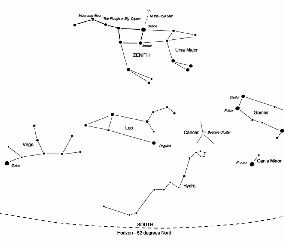
The May Sky in the south - after sunset.
This map shows the constellations seen in the south after sunset.
The constellation Gemini is now setting towards the south-west and Leo holds pride (sic) of place in the south with its bright star Regulus. Between Gemini and Leo lies Cancer - which is well worth observing with binoculars to see the Beehive Cluster at its heart. Below Gemini is the tiny constellation Canis Minor whose only bright star is Procyon. Rising in the south-east is the constellation Virgo whose brightest star is Spica. Though Virgo has few bright stars it is in the direction of of a great cluster of galaxies - the Virgo Cluster - which lies at the centre of the supercluster of which our local group of galaxies is an outlying member. High overhead in the north is the constellation Ursa Major which also contains many interesting objects.
The constellation Gemini
 Gemini
Gemini
Gemini - The Twins - lies up and to the left of Orion and is in the south-west during early evenings this month. It contains two bright stars Castor and Pollux of 1.9 and 1.1 magnitudes respectivly. Castor is a close double having a separation of ~ 3.6 arc seconds making it a fine test of the quality of a small telescope - providing the atmospheric seeing is good! In fact the Castor system has 6 stars - each of the two seen in the telescope is a double star, and there is a third, 9th magnitude, companion star 73 arcseconds away which is alos a double star! Pollux is a red giant star of spectral class K0. The planet Pluto was discovered close to delta Geminorum by Clyde Tombaugh in 1930. The variable star shown to the lower right of delta Geminorum is a Cepheid variable, changing its brightness from 3.6 to 4.2 magnitudes with a period of 10.15 days
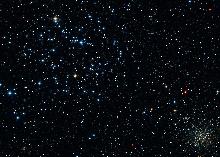 M35 and NGC 2158
M35 and NGC 2158
This wonderful image was taken by Fritz Benedict and David Chappell using a 30" telescope at McDonal Observatory. Randy Whited combined the three colour CCD images to make the picture
M35 is an open star cluster comprising several hundred stars around a hundred of which are brighter than magnitude 13 and so will be seen under dark skies with a relativly small telescope. It is easily spotted with binoculars close to the "foot" of the upper right twin. A small telescope at low power using a wide field eyepiece will show it at its best. Those using larger telescopes - say 8 to 10 inches - will spot a smaller compact cluster NGC 2158 close by. NGC 2158 is four times more distant that M35 and ten times older, so the hotter blue stars will have reached the end of their lives leaving only the longer-lived yellow stars like our Sun to dominate its light.
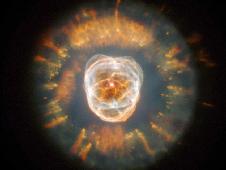 The Eskimo Nebula, NGC2392, Hubble Space Telescope
The Eskimo Nebula, NGC2392, Hubble Space Telescope
To the lower right of the constellation lies the Planetary Nebula NGC2392. As the Hubble Space Telescope image shows, it resembles a head surrounded by the fur collar of a parka hood - hence its other name The Eskimo Nebula. The white dwarf remnant is seen at the centre of the "head". The Nebula was discovered by William Herschel in 1787. It lies about 5000 light years away from us.
The constellation Leo
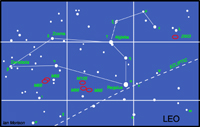 Leo
Leo
The constellation Leo is now in the south-eastern sky in the evening. One of the few constellations that genuinely resembles its name, it looks likes one of the Lions in Trafalger Square, with its manem and head forming an arc (called the Sickle) to the upper right, with Regulus in the position of its right knee. Regulus is a blue-white star, five times bigger than the sun at a distance of 90 light years. It shines at magnitude 1.4. Algieba, which forms the base of the neck, is the second brightest star in Leo at magnitude 1.9. With a telescope it resolves into one of the most magnificent double stars in the sky - a pair of golden yellow stars! They orbit their common centre of gravity every 600 years. This lovely pair of orange giants are 170 light years away.
Leo also hosts two pairs of Messier galaxies which lie beneath its belly. The first pair lie about 9 degrees to the west of Regulus and comprise M95 (to the east) and M96. They are almost exactly at the same declination as Regulus so, using an equatorial mount, centre on Regulus, lock the declination axis and sweep towards the west 9 degrees. They are both close to 9th magnitude and may bee seen together with a telescope at low power or individually at higher powers. M65 is a type Sa spiral lying at a distance of 35 millin klight years and M66, considerably bigger than M65, is of type Sb. Type Sa spirals have large nuclei and very tightly wound spiral arms whilst as one moves through type Sb to Sc, the nucleus becomes smaller and the arms more open.
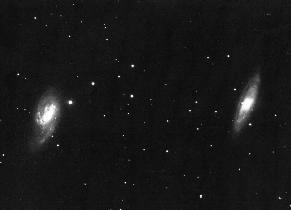 The galaxies M65 and M66
The galaxies M65 and M66
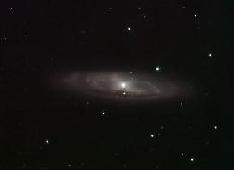
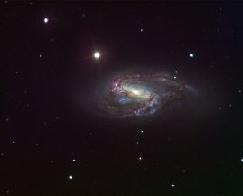 M65 - Type Sa spiral, 9.3 magnitude M66 - Type Sb spiral, 8.9 magnitude
M65 - Type Sa spiral, 9.3 magnitude M66 - Type Sb spiral, 8.9 magnitude
The second pair of galaxies, M95 and M96, lie a further 7 degrees to the west between the stars Upsilon and Iota Leonis. M95 is a barred spiral of type SBb. It lies at a distance of 38 million light years and is magnitude 9.7. M96, a type Sa galaxy, is slightly further away at 41 million light years, but a little brighter with a magnitude of 9.2. Both are members of the Leo I group of galaxies and are visible together with a telescope at low power.
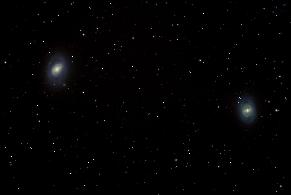 The galaxies M95 and M96
The galaxies M95 and M96
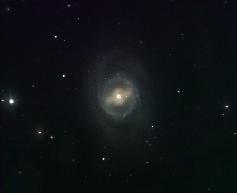
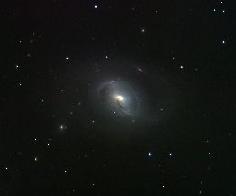 M95 - Type SBb spiral, 9.7 magnitude M96 - Type Sa spiral, 9.2 magnitude
M95 - Type SBb spiral, 9.7 magnitude M96 - Type Sa spiral, 9.2 magnitude
There is a further ~9th magnitude galaxy in Leo which, surprisingly, is in neither the Messier or Caldwell catalogues. It lies a little below lambda Leonis and was discovered by William Herschel. No 2903 in the New General Catalogue, it is a beautiful type Sb galaxy which is seen at somewhat of an oblique angle. It lies at a distance of 20.5 million light years.
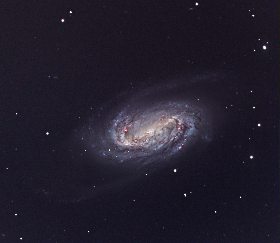 The 8.9th magnitude, type Sb, Galaxy NGC2903
The 8.9th magnitude, type Sb, Galaxy NGC2903
The constellation Virgo
 Virgo
Virgo
Virgo, rising in the east in late evening this month, is not one of the most prominent constellations, containing only one bright star, Spica, but is one of the largest and is very rewarding for those with "rich field" telescopes capable of seeing the many galaxies that lie within its boundaries. Spica is, in fact, an exceedingly close double star with the two B type stars orbiting each other every 4 days. Their total luminosity is 2000 times that of our Sun. In the upper right hand quadrant of Virgo lies the centre of the Virgo Cluster of galaxies. There are 13 galaxies in the Messier catalogue in this region, all of which can be seen with a small telescope. The brightest is the giant elliptical galaxy, M87, with a jet extending from its centre where there is almost certainly a massive black hole into which dust and gas are falling. This releases great amounts of energy which powers particles to reach speeds close to the speed of light forming the jet we see. M87 is also called VIRGO A as it is a very strong radio source.

 The Giant Elliptical Galaxy M87 HST image showing the jet
The Giant Elliptical Galaxy M87 HST image showing the jet
Below Porrima and to the right of Spica lies M104, an 8th magnitude spiral galaxy about 30 million light years away from us. Its spiral arms are edge on to us so in a small telescope it appears as an elliptical galaxy. It is also known as the Sombrero Galaxy as it looks like a wide brimmed hat in long exposure photographs.
 M104 - The Sombrero Galaxy
M104 - The Sombrero Galaxy
The constellation Ursa Major
 Ursa Major
Ursa Major
The stars of the Plough, shown linked by the thicker lines in the chart above, form one of the most recognised star patterns in the sky. Also called the Big Dipper, after the soup ladles used by farmer's wives in America to serve soup to the farm workers at lunchtime, it forms part of the Great Bear constellation - not quite so easy to make out! The stars Merak and Dubhe form the pointers which will lead you to the Pole Star, and hence find North. The stars Alcor and Mizar form a naked eye double which repays observation in a small telescope as Mizar is then shown to be an easily resolved double star. A fainter reddish star forms a triangle with Alcor and Mizar.
Ursa Major contains many interesting "deep sky" objects. The brightest, listed in Messier's Catalogue, are shown on the chart, but there are many fainter galaxies in the region too. In the upper right of the constellation are a pair of interacting galaxies M81 and M82 shown in the image below. M82 is undergoing a major burst of star formation and hence called a "starburst galaxy". They can be seen together using a low power eyepiece on a small telescope.
 M81 and M82
M81 and M82
Another, and very beautiful, galaxy is M101 which looks rather like a pinwheel firework, hence its other name the Pinwheel Galaxy. It was discovered in1781 and was a late entry to Messier's calalogue of nebulous objects. It is a type Sc spiral galaxy seen face on which is at a distance of about 24 million light years. Type Sc galaxies have a relativly small nucleus and open spiral arms. With an overall diameter of 170,000 light it is one of the largest spirals known (the Milky Way has a diameter of ~ 130,000 light years).
 M101 - The Ursa Major Pinwheel Galaxy
M101 - The Ursa Major Pinwheel Galaxy
Though just outside the constellation boundary, M51 lies close to Alkaid, the leftmost star of the Plough. Also called the Whirlpool Galaxy it is being deformed by the passage of the smaller galaxy on the left. This is now gravitationally captured by M51 and the two will eventually merge. M51 lies at a distance of about 37 million light years and was the first galaxy in which spiral arms were seen. It was discovered by Charles Messier in 1773 and the spiral structure was observed by Lord Rosse in 1845 using the 72" reflector at Birr Castle in Ireland - for many years the largest telescope in the world.
 M51 - The Whirlpool Galaxy
M51 - The Whirlpool Galaxy
Lying close to Merak is the planetary nebula M97 which is usually called the Owl Nebula due to its resemblance to an owl's face with two large eyes. It was first called this by Lord Rosse who drew it in 1848 - as shown in the image below right. Planetary nebulae ar the remnants of stars similar in size to our Sun. When all possible nuclear fusion processes are complete, the central core collpses down into a "white dwarf" star and the the outer parts of the star are blown off to form the surrounding nebula.

 M97 - The Owl Planetary Nebula Lord Rosse's 1848 drawing of the Owl Nebula
M97 - The Owl Planetary Nebula Lord Rosse's 1848 drawing of the Owl Nebula

















































